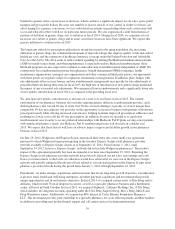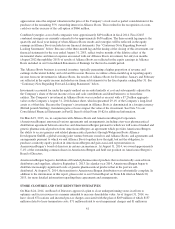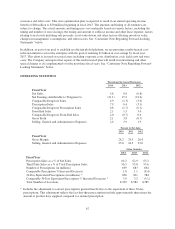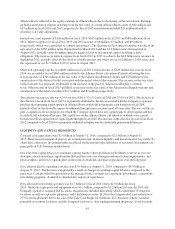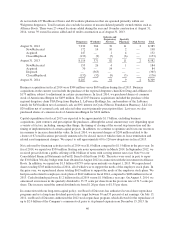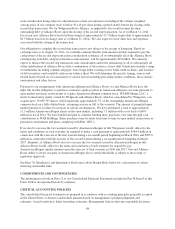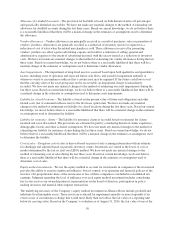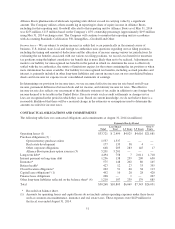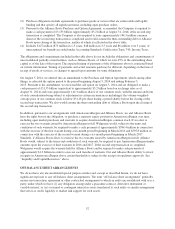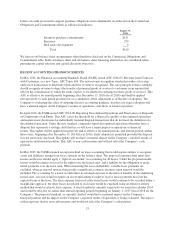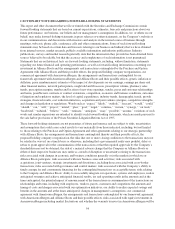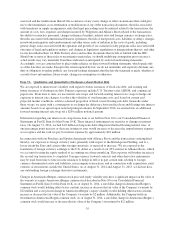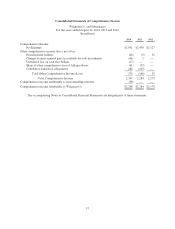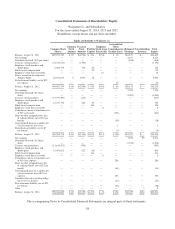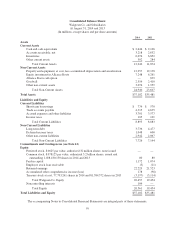Walgreens 2014 Annual Report Download - page 57
Download and view the complete annual report
Please find page 57 of the 2014 Walgreens annual report below. You can navigate through the pages in the report by either clicking on the pages listed below, or by using the keyword search tool below to find specific information within the annual report.from those judgments and estimates would not have a material impact on our consolidated financial position or
results of operations. To the extent that the estimates used differ from actual results, however, adjustments to the
statement of earnings and corresponding balance sheet accounts would be necessary. These adjustments would be
made in future statements. Some of the more significant estimates include goodwill and other intangible asset
impairment, allowance for doubtful accounts, vendor allowances, asset impairments, liability for closed
locations, liability for insurance claims, cost of sales, equity method investments and income taxes. We use the
following methods to determine our estimates:
Goodwill and other intangible asset impairment – Goodwill and other indefinite-lived intangible assets are not
amortized, but are evaluated for impairment annually during the fourth quarter, or more frequently if an event
occurs or circumstances change that would more likely than not reduce the fair value of a reporting unit below its
carrying value. As part of our impairment analysis for each reporting unit, we engage a third party appraisal firm
to assist in the determination of estimated fair value for each reporting unit. This determination includes
estimating the fair value using both the income and market approaches. The income approach requires
management to estimate a number of factors for each reporting unit, including projected future operating results,
economic projections, anticipated future cash flows and discount rates. The market approach estimates fair value
using comparable marketplace fair value data from within a comparable industry grouping.
The determination of the fair value of the reporting units and the allocation of that value to individual assets and
liabilities within those reporting units requires us to make significant estimates and assumptions. These estimates
and assumptions primarily include, but are not limited to: the selection of appropriate peer group companies;
control premiums appropriate for acquisitions in the industries in which we compete; the discount rate; terminal
growth rates; and forecasts of revenue, operating income, depreciation and amortization and capital
expenditures. The allocation requires several analyses to determine fair value of assets and liabilities including,
among other things, purchased prescription files, customer relationships and trade names. Although we believe
our estimates of fair value are reasonable, actual financial results could differ from those estimates due to the
inherent uncertainty involved in making such estimates. Changes in assumptions concerning future financial
results or other underlying assumptions could have a significant impact on either the fair value of the reporting
units, the amount of the goodwill impairment charge, or both.
We also compared the sum of the estimated fair values of the reporting units to the Company’s total value as
implied by the market value of the Company’s equity and debt securities. This comparison indicated that, in total,
our assumptions and estimates were reasonable. However, future declines in the overall market value of the
Company’s equity and debt securities may indicate that the fair value of one or more reporting units has declined
below its carrying value.
One measure of the sensitivity of the amount of goodwill impairment charges to key assumptions is the amount
by which each reporting unit “passed” (fair value exceeds the carrying amount) or “failed” (the carrying amount
exceeds fair value) the first step of the goodwill impairment test. Our reporting units’ fair values exceeded their
carrying amounts ranging from approximately 12% to more than 117%.
Generally, changes in estimates of expected future cash flows would have a similar effect on the estimated fair
value of the reporting unit. That is, a 1% change in estimated future cash flows would change the estimated fair
value of the reporting unit by approximately 1%. The estimated long-term rate of net sales growth can have a
significant impact on the estimated future cash flows, and therefore, the fair value of each reporting unit. Of the
other key assumptions that impact the estimated fair values, most reporting units have the greatest sensitivity to
changes in the estimated discount rate. The Company believes that its estimates of future cash flows and discount
rates are reasonable, but future changes in the underlying assumptions could differ due to the inherent uncertainty
in making such estimates.
We have not made any material changes to the method of evaluating goodwill and intangible asset impairments
during the last three years. Based on current knowledge, we do not believe there is a reasonable likelihood that
there will be a material change in the estimates or assumptions used to determine impairment.
49


